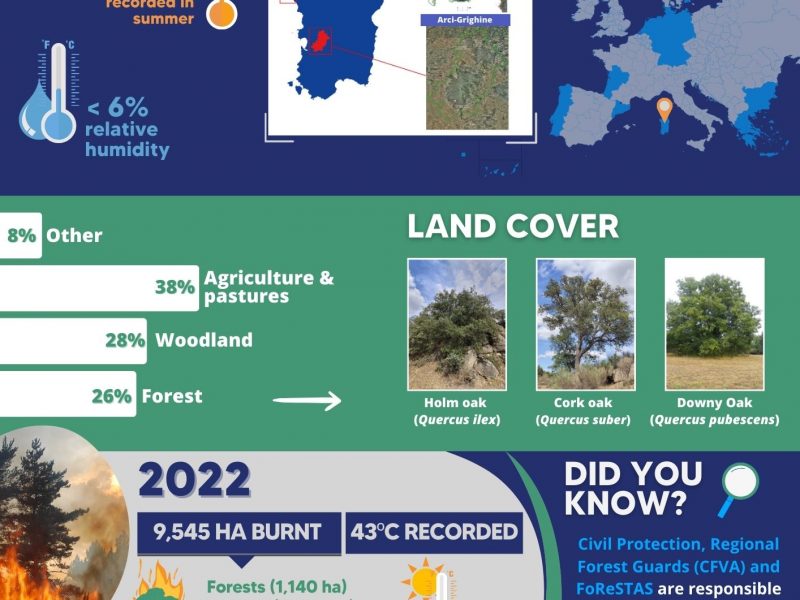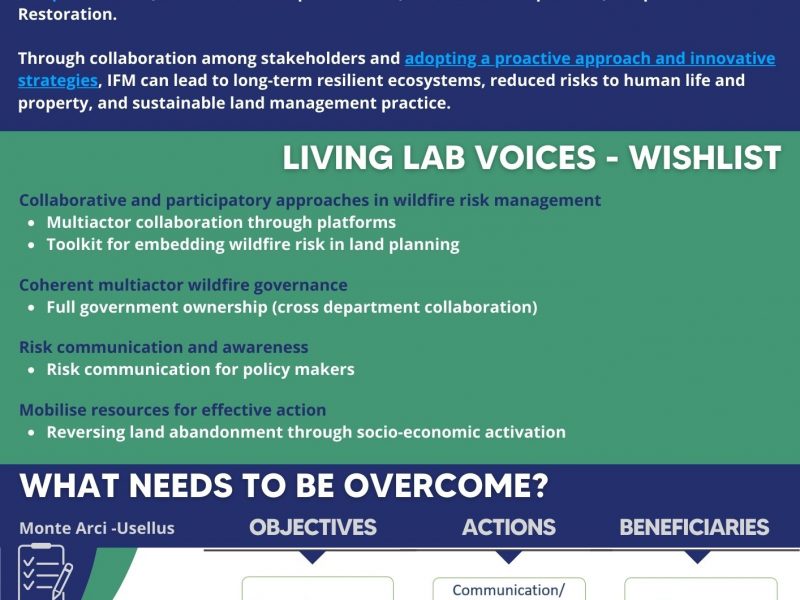CONTEXT
For the Living Lab in Sardinia, FoReSTAS will support the set-up of two field trials on its premises, in two areas: Porto Conte-Alghero, Sassari, and Monte Arci -Usellus, Oristano.
Porto Conte is characterized by Coastal Pine Stands: stone pine and Aleppo pine (Pinus pinea, Pinus halepensis) from afforestation interventions made in the ‘60s. In coastal degraded areas, the Mediterranean maquis and garrigue are present and they offer an interface with tourist and recreational infrastructures along the coast.
In the Monte Arci site, the vegetation is prominently characterized by holm oak (Quercus ilex L.) woodlands, both coppice and high woods or associated to Mediterranean maquis, sometimes interspersed with cork oaks (Quercus suber L.).
FIRE MANAGEMENT IN SARDINIA
The regional fire-fighting system consists of:
- Civil protection (coordinates the civil protection activities of the Regional bodies, the provinces, the municipalities and voluntary organizations);
- Forestry Guards (coordinates operations on the ground and air fleets for fire suppression);
- FoReSTAS Agency (manages fire prevention activities in its forest compendiums and contributes to alerting and fire suppression operations on the ground);
- state entities, voluntary organizations and barracellari companies.

CHALLENGES
- Presence of tourist/forest interfaces prone to fires in coastal areas
- Wide dense even-aged coastal pine stands in need of thinning and pruning operations to reduce fuel load
- Progressive reduction in forest workforce and ageing of workers
- Loss of local traditional knowledge on fire behaviour and forest fire prevention
- Need to identify new tools and machineries for fostering forest operations
- Critical continuum in vegetation cover in fire prone inner areas
- Abandonment of rural areas and reduced stewardship of the land
- Need to reduce fuel load while preserving important habitats
INNOVATION ACTIONS
Advanced Technology Solutions - Support Tools for Integrated Fire Management
IA 5.4. Piloting models for fire combustion and Pyrocumulonimbus with use of HR data
IA 5.5. Testing of vertical atmospheric structure models based on satellite constellation in EWE
IA 5.6. Prototyping HAPS (High Altitude Pseudo Satellites) contribution to Europe’s resilience against EWE
IA 5.10. Development of a Pan-European system to define management priorities to mitigate fire impact
Factsheets
A set of factsheets was produced by forestWISE to interactively complement the information available on the Living Lab.
PARTNERS
{{ group }}
{{ object.name }}
{{ object.name }}
{{ object.subheader }}
{{ icon.replace(/^icon_/, '') }}
{{ label }}
Contact

Sara Maltoni
- FoReSTAS
- smaltoni@forestas.it

Corinne Caddeo
- FoReSTAS
- ccaddedo@forestas.it

